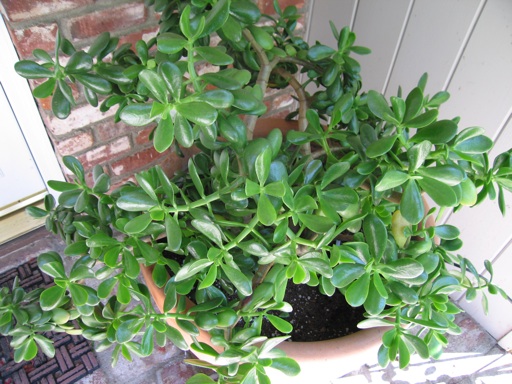
Several years ago, my mother gave me this jade plant. I planted it in the ground near our house, but it didn’t seem to like that location. It hadn’t grown for years, probably due to a lack of regular watering and insufficient sunlight. Last year, my partner and I transplanted our jade plant into a large clay pot, where it gets a regular watering from our micro-spray system. The pot is located under a porch where it gets about an hour or two of late afternoon sun.
It seems to be liking its new location. Our jade plant has grown significantly since we transplanted it into this pot. Its leaves are thick and have a deep green color. Although, our jade plant has yet to bloom for us. Jade plants are supposed to produce little star-shaped pink flowers.
Many of the jade plants I see growing in our area have pale green or even yellow leaves. I think the pale color is due to insufficient watering.
September 26 2009 | Jade | Comments Off on Jade Plant in Clay Pot
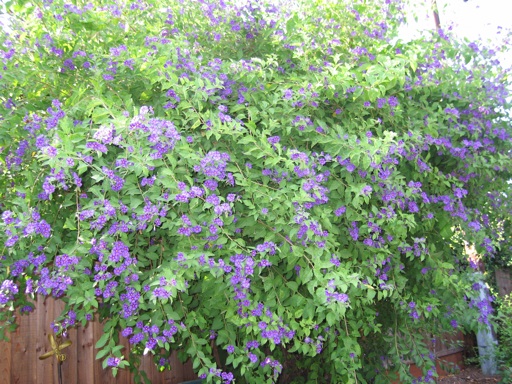
Potato vine solanum is a beautiful landscape bush. This is a recent photograph of our potato vine solanum bush. It needs more pruning than any other plant in our yard, because it grows numerous long spindly branches very quickly. Our solanum bush needs to be pruned about every two months during the growing season to keep it looking neat.
Right now, our bush is full of purple flowers, but it is huge and overgrown. I haven’t pruned it since June. When I do get around to pruning it, it usually takes me about 2 hours to prune it back into its original shape and then clean up the huge mass of branches.
September 20 2009 | Solanum | Comments Off on Potato Vine Solanum
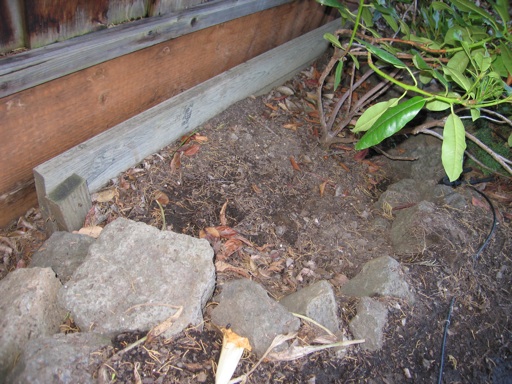
I came across this interesting article in a local publication recently. It discusses the use of wood treated with chromated copper arsenate (CCA) in garden beds. Wood is treated with chemicals such as CCA to kill microorganisms and insects that can cause the wood to decay. The article discussed the possibility that people who build their vegetable gardens using wood treated with CCA might end up consuming arsenic that leached into the soil from the wood.
In 2004, the Department of Soil, Water, and Climate at the University of Minnesota published a study of vegetables grown near wood that has been treated with CCA. In the study, the researchers discovered that plants grown within a few centimeters of CCA treated wood absorbed significantly greater concentrations of arsenic than plants grown several feet away from the wood. Although they concluded that based on U.S. Public Health Service standards these vegetables would be safe for human consumption, they also stated that some of the vegetable crops may not be safe for sustained consumption based on the US EPA’s standard.
In 2004, the Environmental Protection Agency (EPA) in a voluntary agreement with industry began restricting the use of CCA in treated timber in residential and commercial construction, with some exceptions.
However, just a few weeks ago, I discovered a piece of lumber in my yard (see above picture) that had a yellow tag stapled onto it. The lumber was placed around a raised bed near our fence by the previous owners of our house. The yellow tag indicated that the wood had been treated with CCA. I had a rosemary bush growing next to that piece of lumber for years. I also have two orange bushes growing about 6 feet away from it. Based on the results of the University of Minnesota study, I think that our oranges are far enough away from the treated lumber to have avoided absorbing much arsenic from it. But I have pulled up the rosemary bush, and I plan on removing the treated piece of lumber soon.
September 19 2009 | Vegetables | Comments Off on Arsenic in the Garden
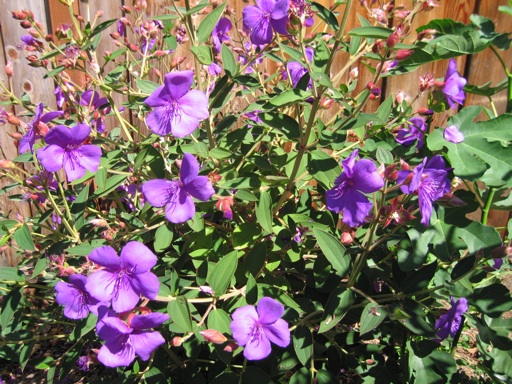
Our princess flower bush defoliated and nearly died last January during a freeze when the temperature fell into the high 20s F. It has made a big comeback since then. It has grown quickly all spring and summer. It’s now full of purple flowers and looking great. Regular watering every other day is probably one of the reasons it has grown so fast. It is getting about 8 hours of sun a day, but I have not fertilized it. I pulled up a climbing rose that was crowding it before, and that seems to have helped also.
September 05 2009 | Princess Flower | Comments Off on Princess Flowers
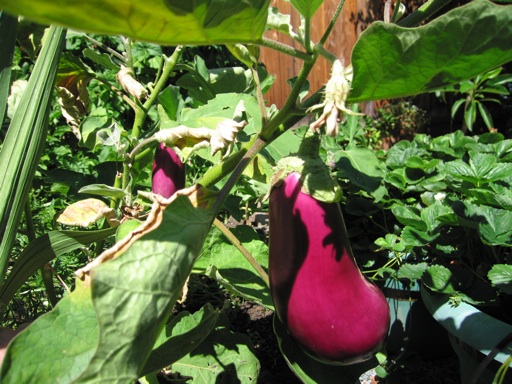
This photograph shows our neon eggplant with a large purple fruit hanging on it. We are also growing millionaire and nadia eggplants. This is the second year we have grown eggplants in our vegetable garden, and I have been pleased with the harvest both years. Our eggplants are slow growers early in the season and don’t produce fruit until later than many of our other garden vegetables. But by August, when the summer heat really kicks in, our eggplants started growing faster and producing a decent amount of fruits.
Last weekend, my partner and I made Wolfgang Puck’s vegetable gratin recipe using our home grown tomatoes, eggplants, zucchini, thyme leaves, and onions. The rest of the ingredients we used in the recipe were store bought, including the mushrooms we added to the recipe. Even with the two of us working together, it took nearly three hours to make it. It takes a long time to fry all that zucchini and eggplant.
But the end product was absolutely delicious! This vegetable gratin recipe is one of my favorites. We have made this recipe several times in the past, and we both think that this time it tasted better than ever. I attribute that flavor in part to using mostly home grown produce. The eggplants we used were so fresh, because I picked them that day, and the neon eggplants had a nice creamy white interior. I picked the zucchinis only a few days before. And all of our home grown eggplants and zucchinis had very few of the scratches, blemishes, and wrinkled spots I often see on commercial produce.
August 30 2009 | Eggplant | Comments Off on Neon Eggplant
« Prev - Next »




